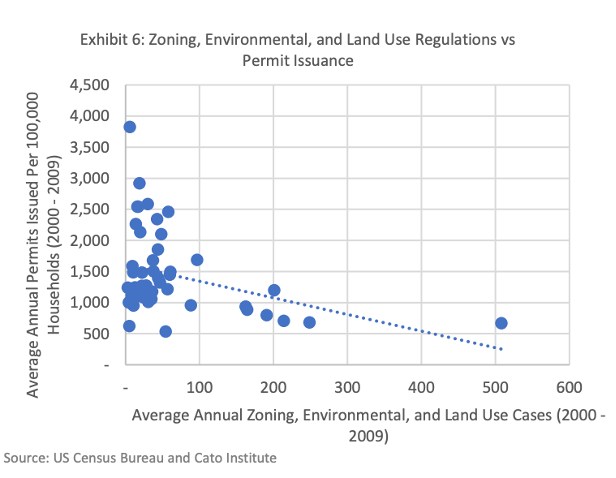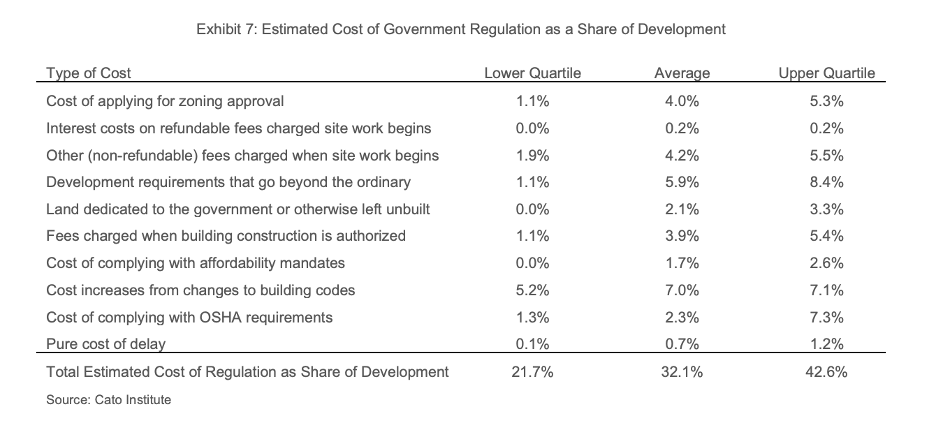Increasingly stringent local zoning, land use, and environmental laws and regulations are arguably the most significant headwinds adversely impacting housing production. State and local regulations impose significant risk elements and unproductive costs and serve to limit not only where new housing can be developed, but also constrain the asset class, product type, density, material, and style of new developments.
Although the regulations began as well intentioned, and were designed to manage the widespread development of office and industrial land uses near existing retail and residential areas following the growth of the Industrial Revolution, the decades-long accumulation of regulations created an onerous process limiting new development nationwide; overly restrictive regulations, veto-empowered planning commissions, and punitive development exactions collectively served to limit future home and apartment supply.
While the localized nature of land use regulations makes comprehensive analysis of their proliferation a challenge due to their number and variation, it is clear they have increased substantially over time. Between 1980 and 2009, the number of zoning, land use, and environmental cases that passed through US courts annually increased 100.4%, Kingbird Analysis of Cato Institute Data. The number of households and housing units in the US expanded 39.5% and 49.9%, respectively, during that same period, according to Kingbird Analysis of US Census Bureau Data. This mismatch in growth suggests that regulations and their enforcement grew substantially in “real” terms and indicates that, as regulations proliferate, the US housing supply situation worsens.
 The effects of these strict and abundant regulations cannot be overstated. As displayed in Exhibit 6, there is a negative relationship between the number of annual zoning, environmental, and land use court cases and the number of permits issued per state, relative to its number of households. States with a higher average number of cases typically have a lower level of permit issuance, when adjusted for household count. Less permits issued means fewer residential deliveries, exacerbating the housing shortfall locally. Exacerbating this, between 2006 and 2018, 49% of metropolitan areas nationwide increased the burdens of their land use regulations by creating new or strengthening existing entities in the approval process and/or increased project review timelines. Another 18% of the nation’s metropolitan areas saw no change in regulatory strictness, according to Gyourko, J, Hartley, J, and Krimmel, J The Local Residential Land Use Regulatory Environment Across U.S. Housing Markets: Evidence from a New Wharton Index National Bureau of Economic Research (2019).
The effects of these strict and abundant regulations cannot be overstated. As displayed in Exhibit 6, there is a negative relationship between the number of annual zoning, environmental, and land use court cases and the number of permits issued per state, relative to its number of households. States with a higher average number of cases typically have a lower level of permit issuance, when adjusted for household count. Less permits issued means fewer residential deliveries, exacerbating the housing shortfall locally. Exacerbating this, between 2006 and 2018, 49% of metropolitan areas nationwide increased the burdens of their land use regulations by creating new or strengthening existing entities in the approval process and/or increased project review timelines. Another 18% of the nation’s metropolitan areas saw no change in regulatory strictness, according to Gyourko, J, Hartley, J, and Krimmel, J The Local Residential Land Use Regulatory Environment Across U.S. Housing Markets: Evidence from a New Wharton Index National Bureau of Economic Research (2019).
Burdensome regulations impose significant financial disincentives on new construction; an estimated 32% of multifamily projects’ total development costs are attributable to regulatory burdens, as shown in Exhibit 7 below, implying that multifamily building costs would be 32% less expensive if it was not for regulatory costs.

This increase in costs has two core effects: 1) it disincentivizes construction which reduces supply; and 2) it forces developers or managers to charge higher prices or rents to offset the additional costs. For example, each regulation that a city in California enacts is associated with an estimated 4.5% and 2.3% increase in the cost of owner-occupied and rental housing, respectively, according to Cato Institute Zoning, Land-Use Planning, and Housing Affordability (October 2017). Either effect reduces the supply of affordable housing.
 The effect of this regulatory burden on multifamily construction is made clear when the number of multifamily building deliveries are examined in conjunction with zoning, environmental, and land use court cases by region. As shown in Exhibit 8, of the four US regions — Northeast, South, Midwest, and West — those with the least number of court cases experienced the greatest number of multifamily completions, a clear negative relationship. The South, which had the fewest cases annually, on average, had the most average completions per year. The West, which had the second fewest, had the second most, while the Midwest, which had the third fewest zoning, environmental, and land use cases, had the third most multifamily deliveries. Finally, the Northeast region, which, between 1994 and 2009, had the highest number of regulations move through its courts, experienced the fewest successful deliveries of multifamily buildings among all four regions.
The effect of this regulatory burden on multifamily construction is made clear when the number of multifamily building deliveries are examined in conjunction with zoning, environmental, and land use court cases by region. As shown in Exhibit 8, of the four US regions — Northeast, South, Midwest, and West — those with the least number of court cases experienced the greatest number of multifamily completions, a clear negative relationship. The South, which had the fewest cases annually, on average, had the most average completions per year. The West, which had the second fewest, had the second most, while the Midwest, which had the third fewest zoning, environmental, and land use cases, had the third most multifamily deliveries. Finally, the Northeast region, which, between 1994 and 2009, had the highest number of regulations move through its courts, experienced the fewest successful deliveries of multifamily buildings among all four regions.
Further, many zoning, land use, and environmental regulations are specifically designed to limit the supply of multifamily housing as local homeowners believe it negatively impacts home values and actively advocate against their construction. Reflecting this, the number of multifamily buildings delivered annually in the US declined from 23,000 in 1994 to 12,000 in 2021, according to US Census Bureau, National Library of Medicine NIMBYism as a barrier to housing and social mix in San Francisco (2022), and Kingbird Analysis of Federal Reserve Bank of St. Louis, Bureau of Labor Statistics, and CoStar Commercial Repeat Sale Index Data.
Although initially well intentioned, the prevalence of these regulations throughout the US has increased the cost and number of regulatory hurdles that must be overcome by builders. This limits the ability of developers to respond to the housing shortage and drives up construction costs. As these regulations are unlikely to go away in the near and intermediate term, and because in-place residents have limited incentive to support modifying prevailing rules that empower current residents, future and potential residents are severely disadvantaged. They are either forced to pay more to live in a community or are excluded altogether.





